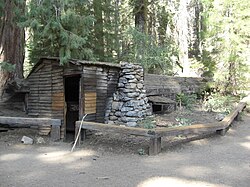Hale Tharp: Difference between revisions
m Disambiguate Yokut to Yokut people using popups |
m precise -- what is known |
||
| Line 11: | Line 11: | ||
[[Tharp's Log]] is a home Tharp built in a hollowed [[Sequoiadendron|giant sequoia]] log at Log Meadow. It is restored and visited by tourists today, and is on the [[National Register of Historic Places]]. |
[[Tharp's Log]] is a home Tharp built in a hollowed [[Sequoiadendron|giant sequoia]] log at Log Meadow. It is restored and visited by tourists today, and is on the [[National Register of Historic Places]]. |
||
Tharp, along with stepsons George and John Swanson, were the first |
Tharp, along with stepsons George and John Swanson, were the first non-Native Americans known to ascend the granite dome [[Moro Rock]].<ref>[http://www.kaweahcommonwealth.com/sequoiaandkingsnationalparkhistory.html kaweahcommonwealth.com]</ref> |
||
Revision as of 14:09, 1 September 2010

Hale Dixon Tharp was a miner during the California Gold Rush, and the first non-Native American to enter Giant Forest, in what is now Sequoia National Park.
Tharp was born in Michigan in 1828. In 1851, a widow from Illinois, Chloe Ann Smith Swanson, hired Tharp to take her and her four sons to California in a covered wagon with two teams of oxen. They settled in Placerville, where Tharp married Swanson.[1] Tharp then began mining in California’s Gold Country.[2]
In the summer of 1856, Tharp went to Tulare County to establish a preemption homestead, with the intent to return later to ranch cattle. He built a shake and brush shack near the confluence of the Kaweah River and Horse Creek, east of Visalia and south of Three Rivers. He then returned to Placerville.[2]
Two years later, Tharp, along with his brother-in-law John Swanson, returned to his homestead and built a log cabin and barn. Tharp then sought cattle summer pasturage. Led by local Yokut Indians, Tharp discovered Crescent Meadow and Log Meadow, in present-day Sequoia National Park. He claimed grazing rights there for several years.[2]
Tharp's Log is a home Tharp built in a hollowed giant sequoia log at Log Meadow. It is restored and visited by tourists today, and is on the National Register of Historic Places.
Tharp, along with stepsons George and John Swanson, were the first non-Native Americans known to ascend the granite dome Moro Rock.[3]
